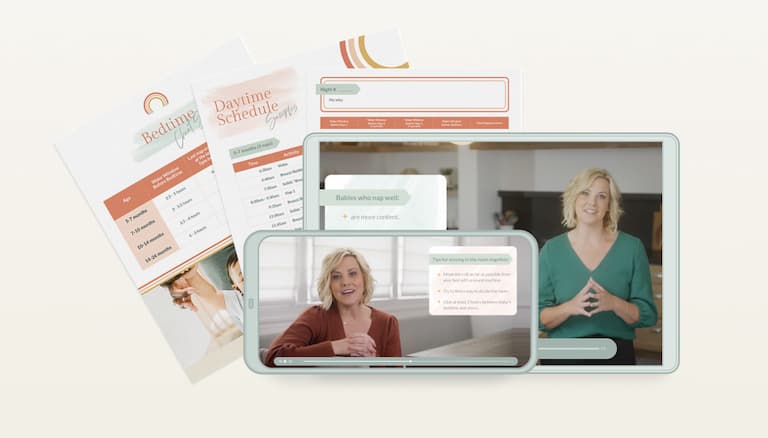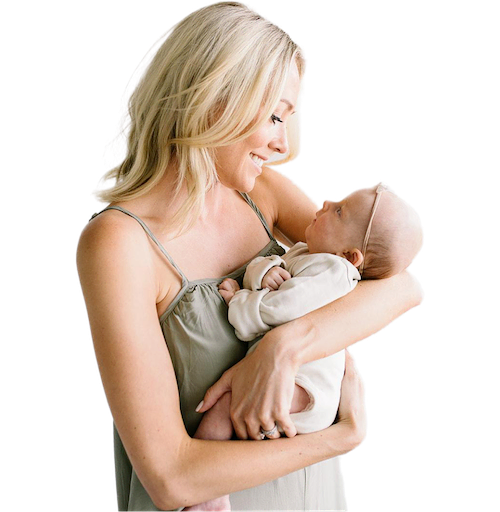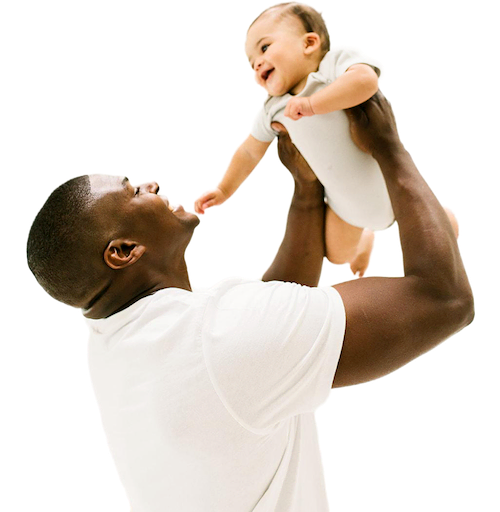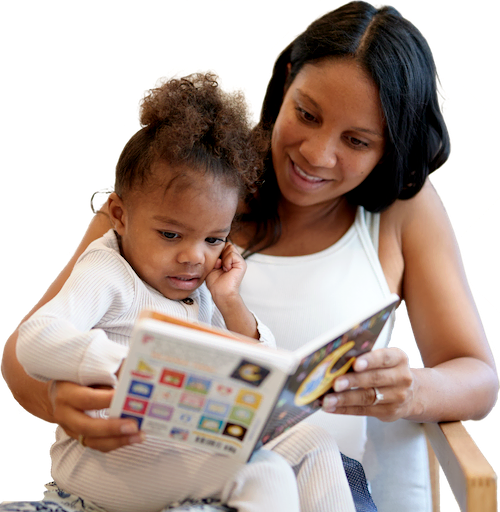Are you noticing some changes in sleep around 14-15 months? You might be seeing what some may call the 14-15 month sleep regression. Let’s talk about what this might look like and how to help your little one if sleep is challenging.

The 5–24 Month Collection
stars ( reviews)
If sleep seems to be falling apart in the middle of a regression, please know that you don't have to just wait it out and hope for the best. My classes will meet your little one right where they are developmentally. There's no need to wait, you can start now.
Learn MoreWhat is a sleep regression?anchor
A sleep regression is a change where your baby’s sleep becomes more disrupted. Sleep regressions are often associated with developmental progression. When babies experience growth (physical, mental, emotional), sleep can be impacted. Their brains and bodies are working hard!
Are sleep regressions based in science?anchor
When a baby’s brain is busy learning new things or developing, sleep can take a back seat.(1, 2) Also, as babies grow, their sleep needs change.(3,4,5) This means a baby may begin to struggle with more night wakings, with nap refusals, and with falling asleep. When sleep is interrupted this way, it can feel like everything is moving backwards, hence the term “sleep regression.”
However, sleep isn’t actually going backwards or permanently “regressing.” Sleep skills don’t just disappear at magical ages. When I talk about common sleep regression ages, I’m talking about ages when babies and toddlers often experience periods of development (physical, cognitive, social) or commonly have a change in sleep needs (Think fewer naps, more awake time, etc..). But truly, all babies develop at their own pace, meaning sleep could be interrupted because of new skills, cognitive progressions, or physical shifts at any age.
Is there a sleep regression at 14 or 15 months? anchor
There can be a sleep regression at this age! It’s a less common sleep regression, but families can see challenges in sleep around 14-15 months. Perhaps your 14 month old is suddenly waking up at night, your 15 month old is fighting naps, or your 16 month old is now waking earlier and earlier. If you are seeing changes in sleep around 14-15 months, you may be experiencing a sleep regression.
What causes a sleep regression at 14 or 15 months?anchor
Sleep regressions can happen at any age and are often tied to developmental progressions. The most common ages to see sleep regressions are at 4 months, 8-10 months, 12 months, 18 months, and 2 years. However, any time a baby’s brain and body are growing physically, mentally, and emotionally, sleep can be impacted.
Let’s talk about reasons you may see a sleep regression around 14 or 15 months:
Developmental progression: Around 14-15 months, your toddler may be taking a few steps, walking independently, or even climbing on furniture or stairs. You may notice your 14 or 15 month old is trying to be more independent and starting to imitate your actions, like “cleaning” up or trying to put on their own socks. Sleep may look different while your 14-15 month old is learning these new skills; their brains and bodies are working hard!
Separation Anxiety: As your little one becomes more independent and mobile, you may find that they actually need more reassurance that you’re nearby. Your presence gives them confidence to explore their world more freely. Your toddler may also better understand the concept of object permanence. This combination often results in a peak in separation anxiety.
Big transitions: Transitions like switching from breastmilk or formula, transitioning from bottle to cup, weaning from nursing, moving to a new room at daycare, or weaning the pacifier may happen around 14-15 months. These changes can present new sleep challenges as your baby adjusts to new expectations.
Expert Tip: Please know that I understand some transitions are outside of your control. However, if there is a transition that you can control, pay attention to timing and try to only make one big transition at a time.
Changes in sleep needs: As babies get older, their sleep needs change. Some 14-15 month olds may need a bit more awake time between naps or increased activity during awake time. Some may be ready to make the transition to one nap. These shifts can cause some sleep disruptions for your 14 or 15 month old.
Teething: During these next few months, your 14 or 15 month old may have some new teeth popping up (hello, first year molars!). While teething can be a temporary culprit of sleep disruptions, having a strong sleep foundation can make a big difference.
What are some signs of a 14-15 month sleep regression? anchor
Here are some signs of a 14-15 month sleep regression:
Your 14 month old is waking in the middle-of-the-night when this wasn’t happening before.
Your 15 month old is crying when you begin the bedtime routine.
Your 16 month old is taking longer than 20 minutes to fall asleep at bedtime or nap time.
Your 14 month old is screaming when being laid down or when you enter the nursery.
Your 15 month old is refusing to nap or taking short naps.
Your 16 month old is waking before 6:00 am when this wasn’t an issue before.
Your little one’s sleep feels “off,” and you’re not sure why.
How long does the 14-15 month sleep regression last?anchor
Fortunately, a 14-15 month sleep regression is temporary and typically only lasts 1-2 weeks. Your baby‘s body and brain are busy making big developmental progressions, but I want to reassure you that they are not losing their sleep skills. You can make a big difference in the length and impact of a sleep regression by remaining consistent with your approach to sleep. Check out my best tips to help this sleep regression pass quickly.
What can I do to help my toddler with their separation anxiety? anchor
Around 14 or 15 months, your toddler is better understanding the concept of object permanence, which can lead to increased separation anxiety. That increased separation anxiety can make sleep challenging! This may look like crying when entering their room, crying when laid in the crib, or standing in the crib and fighting sleep. Here’s the good news: you CAN help your toddler with separation anxiety!
Consider these other tips:
Play games like Peek-a-Boo or Hide-and-Seek. These help your 14 or 15 month old continue to explore and understand the concept of object permanence (the idea that you are present even when you're out of sight).
Spend awake time in your toddler’s room. This reminds them that their room is a safe space. Bring in a few toys and play together on the floor. Show them that you enjoy being in their room too! I like to do this in the middle of a wake window so there isn’t any pressure around sleep, and you can both just enjoy the space.
Practice planned separation. What does that look like? If you are in a two-caregiver household, let the other parent do bedtime. See if Grandma or a babysitter can come over while you run to the grocery store. Even supervising your child from across the room or just outside of their view can be good practice. These small steps can make a big difference!
Stay calm and consistent. Our children mirror our emotions. Your response reassures your toddler that they are safe and loved. Empathize with them and provide reassurance, but do your best to stay calm.
Expert Tip: If your 14 or 15 month old seems to be fighting sleep in the crib and you’re wondering if it’s time to transition to a toddler bed, please know, I find most toddlers this age sleep best in a crib. At 14-15 months, little ones are just not yet developmentally capable of understanding the need to stay in bed or resisting the urge to get out of bed.
Important Note: Please be sure the crib mattress is in the lowest position and consider a sleep sack to deter crib climbing.
Can we sleep train during the 14-15 month regression? anchor
Yes! The 14-15 month regression can be the perfect time to work on healthy sleep habits. The consistency of a sleep training plan allows your little one the sleep they need to support healthy development.
If you’re considering sleep training and not sure where to start, my 5–24 Month Collection is a holistic, fully-customizable, step-by-step plan that will teach you everything you need to know to have a great little sleeper for nights, naps, regressions and other bumps along the way.
How can I help my baby get through the 14-15 month sleep regression? anchor
Here are my tips for helping your baby during this regression:
1. Practice new skills during awake time.anchor
Encourage your little one to use their new physical skills by giving them time to cruise along furniture, toddle around, or climb up stairs (with supervision, of course). Sing songs together as you change your little one’s diaper to help them practice those new words. Spend time stacking blocks to develop hand-eye coordination and problem solving. Allowing your little one to practice new skills during the day makes them seem less exciting when it’s time to sleep.
2. Plan for active awake time.anchor
As babies get older, they need and want more stimulation. Before making any changes to your 14-15 month’s old daily routine, take a look at what they’re doing during wake windows. Do they have lots of opportunities to move their body and explore the world around them?
Playing during active awake time is so important for sleep. Just like grown ups, your 14 or 15 month old’s physical and mental activity helps them sleep better.
3. Consider changing sleep needs.anchor
Around 14-15 months, wake windows may need adjusting. If your little one is on the lower end of the age-appropriate wake windows, add 10-15 minutes to each wake window. A gradual increase helps prevent overtiredness. Give your baby a few days to adjust before adding more time.
Curious about what those wake windows or daily sleep schedules should look like? I have a 14 month old sleep schedule and 15 month sleep schedule ready for you!
Expert Tip: If your 14 or 15 month old recently started showing signs it’s time to move to one nap, it might not be time to drop the nap just yet! Waiting until your toddler has been consistently showing these signs for a week or two can make the transition much smoother.
4. Stay consistent. anchor
Finding ways to be consistent, especially with healthy sleep habits, is key to getting through any regression. Avoid starting new habits that you don’t want to maintain. This regression can make sleep tricky for several days, but staying consistent with your approach will help.
5. Have a plan.anchor
If your nights or naps have been a struggle for awhile, I have a class for you! The 5-24 Month Collection will give you a step-by-step plan to restful nights and solid naps even through sleep regressions. Please know: it's not too late to have a great little sleeper. I'll walk you specifically through how to customize your sleep plan to meet your 14-15 month old right where they are developmentally.
References
6 Sources
Scher et. al. (2015). Sleep as a mirror of developmental transitions in infancy: The case of crawling.
Healthy Children, American Academy of Pediatrics. (2022). Separation anxiety and sleeping.
Wielek, T. et al. (2019). On the development of sleep states in the first weeks of life.
Paruthi, S. et al. (2016). Recommended Amount of Sleep for Pediatric Populations: A Consensus Statement of the American Academy of Sleep Medicine.
Mindell J. et al. (2016). Development of infant and toddler sleep patterns: real-world data from a mobile application.
A.D.A.M. Medical Encyclopedia. MedlinePlus. (2022). Separation anxiety in children.
Keep in mind that the information and content on this blog is for informational purposes and should not be considered medical advice. If you have questions about your child, please reach out to your doctor.








